|
|
Created/dedicated as per personal communication with Mike Belcher, 2008
Updated as per James P. Tuttle's The Hawk Moths of North America, January 24, 2009
Updated as per personal communication with Diane Grimaudo (Eumorpha achemon, Windsor, August 7, 2016); August 9, 2016
Updated as per Bamona, August 9, 2016 (still does not include ophthalmica or drupiferarum)
|
Sonoma County
Sphingidae
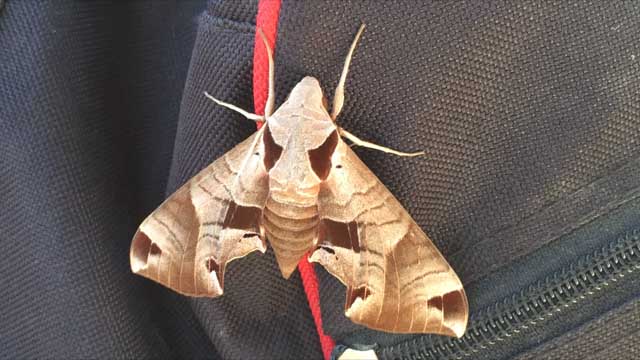
Eumorpha achemon, Windsor, Sonoma County, California,
August 7, 2016, courtesy of Diane Grimaudo.
Thirty-two Sphingidae species are listed in the USGS (now BAMONA) for California. Not all of the species are reported by the USGS for
Sonoma. The twelves species, below, are listed by the USGS for Sonoma County. I have added Sphinx drupiferarum which I think is probably present and
Smerinthus ophthalmica which possibly replaces Smerinthus cerisyi west of the Continental Divide.
It is hoped that this checklist, with the thumbnails and notes, will help you quickly identify the moths you have encountered.
This page is dedicated to Mike Belcher (MB) of Sebastopol, Sonoma County, California.
Mike writes, April 14, 2008, "I saw a Smerinthus cerisyi on my front porch yesterday, April 13th. We live on Hutchinson Road, just
south of the town of Sebastopol, California, in Sonoma county. This is about an hour north of San Francisco for a point of
reference. Thought you might want to add this to your data base. Enjoyed your website."
In 2010, Smerinthus ophthalmica, which had been synonymized with Smerinthus cerisyi, was given full species status based on DNA barcoding results.
Those specimens from Sonoma, previously thought to be S. cerisyi, are more likely Smerinthus ophthalmica. Bill Oehlke
A USGS indicates the moth is reported on the USGS website and/or in Moths of Western North America, #2. Distribution of Sphingidae of
Western North America, revised, an excellent little booklet available through Paul Opler.
Many thanks to Diane Grimaudo who provides the image of Eumorpha achemon at the top of the page.
Diane writes, "This moth just showed up on my softball bag yesterday in Windsor California. I had never seen anything like it and wanted to see if I could find out
about it and read your page. Very interesting moth. They are docile; I couldn't get it
off of my bag we even try getting it to fly off by using a stick and it would budge. We were able to spread its wings and see the red color, it's pretty cool."
Please help me develop this list with improved, documented accuracy by sending sightings (species, date, location), preferably with an
image, via email to Bill Oehlke.
Sphinginae subfamily
Sphingini tribe:
 |
This large bodied moth flies in tobacco fields and vegetable gardens
(potatoes, tomatoes) and wherever host plants are found. |
 |
If you grow tomatoes, you have probably encountered it.
Larvae get very large and can strip a tomato plant. |
 |
Sphinx chersis
USGS, the Northern Ash Sphinx or Great Ash Sphinx.
The upperside of the forewing is soft dark-gray to blue-gray with a series of black dashes, one reaching the wing tip. Note grey thorax with narrow black lines.
|
 |
Forewings, long and slender, are held close to the body when the moth is at rest.
I only see them occasionally on P.E.I. despite visiting lights frequently.
|
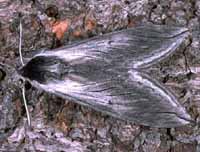 |
Sphinx perelegans adults fly in montane woodlands and mixed chaparral-type vegetation as a single brood
in the north, with adults mainly on the wing in June and July.
It flies from dusk until after midnight. Note dark thorax. |
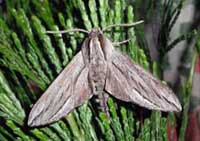 |
Adults fly as a single brood in the desert and in pinyon-juniper
woodland from May to August. |
Smerinthini Tribe:
 |
This one is quite similar to Pachysphinx modesta, with modesta
being smaller and darker.
Moths should be on the wing from June-August.
|
 |
Smerinthus cerisyi
USGS/MB, the Cerisyi's
Sphinx or One-eyed Sphinx, Larvae feed on poplars and willows.
Flight would be from mid April-July as a single brood.
|
Smerinthus cerisyi (more likely ophthalmica), Mike Belcher, Sebastopol, April 13, 2008
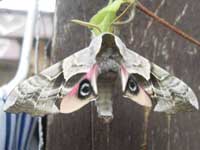 | Larvae feed on poplars, aspen and willows.
Note different shape of double arced forewing pm line compared to the straighter pm line of cerisyi, which it replaces in WA.
S. ophthalmica has smoother scalloping of the fw outer margin.
|
Macroglossinae subfamily
Dilophonotini Tribe:
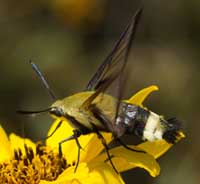 |
Hemaris thetis USGS, the Thetis Clearwing or Bee Hawk Moth,
The moth flies along forest edges and in meadows, gardens and
brushy fields. Day-flying adults nectar at lantana, dwarf bush honeysuckle,
snowberry, orange hawkweed, thistles, lilac, Canada violet, etc.
|
Philampelini Tribe:
 |
This species should be present wherever grapes are found. Fight would be from June to August. Larvae feed on grape foliage.
|
Eumorpha achemon, Windsor, August 7, 2016, Diane Grimaudo.
Macroglossini Tribe:
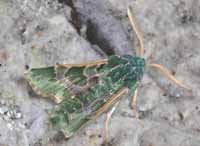 |
Arctonotus lucidus
USGS, the Pacific Green
Sphinx Moth or Bear SphinxThis species is confirmed in Sonoma
County.
It tends to be an late winter-early spring flier, on the
wing in the early evening. It comes to lights at night. |
 |
Hyles lineata
USGS,
the White-lined Sphinx
Adults usually fly at dusk, during the night, at dawn, and during the
day. Moths nectar at salvia and oviposit on Epilobium cana
(California fuchsia) and Hooker's Evening Primrose. |
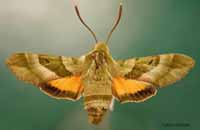 |
Proserpinus clarkiae
USGS, Clark's Sphinx.
Adults fly in the afternoon from April-June in oak woodland and
pine-oak woodland in foothills, nectaring from chia, heartleaf
milkweed, golden currant, bluedicks, fairyfans, vetches,
thistles, hedgenettles, etc. |
|
|
Enjoy some of nature's wonderments, giant silk moth cocoons.
These cocoons are for sale winter and fall. Beautiful Saturniidae moths will emerge the following spring and summer.
Read Actias luna rearing article. Additional online help available.
Use your browser "Back" button to return to the previous page.
This page is brought to you by Bill Oehlke and the
WLSS. Pages are on space rented from Bizland. If you would like to become a "Patron of the Sphingidae/Catocala Sites", contact Bill.
Please send sightings/images to Bill. I will do my best to respond to requests for identification help.
 | 
Show appreciation for this site by clicking on flashing butterfly to the left.
The link will take you to a page with links to many insect sites. |


